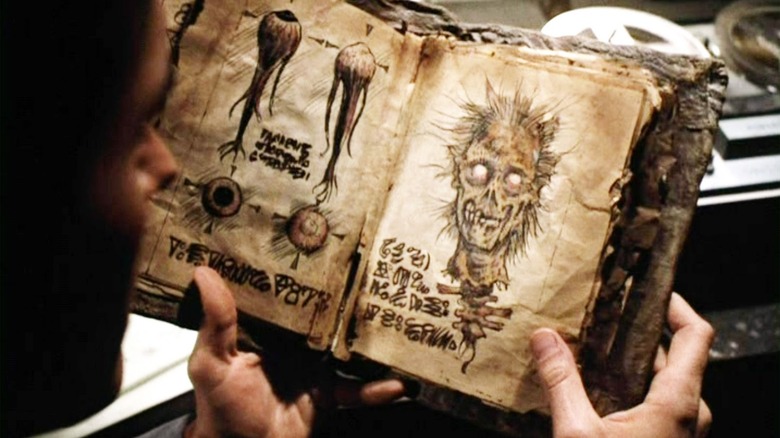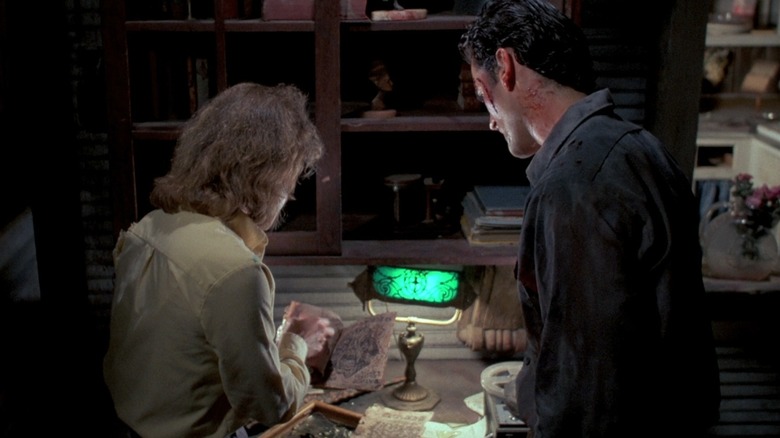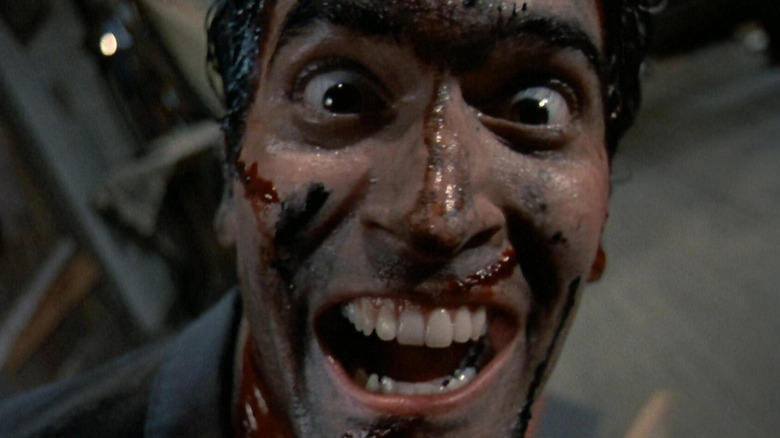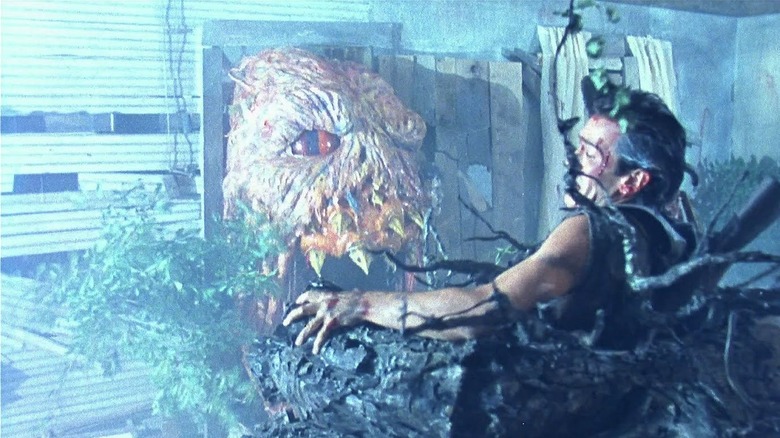Evil Dead II Ending Explained: Ash Vs. The Concept Of Horror Movies
In terms of its plot, Sam Raimi's 1987 splatstick horror freakout "Evil Dead II" (or "Evil Dead 2: Dead by Dawn," both are correct) is hardly complicated. Hapless college student Ash (Bruce Campbell) and his girlfriend Linda (Denise Bixler) head to a remote cabin in the woods for some privacy. In the cabin's earthen basement, Ash finds a mysterious, evil book that is bound in human flesh and inked in blood. A nearby tape recording explains that this book is the Necronomicon, an ancient Sumerian book of demon spells. The tape was left behind by an archeologist who was studying it. When Ash listens to the pre-recorded spells, it summons a demonic force that possesses Linda. The bulk of "Evil Dead II" details Ash's one-man struggle with the forces of darkness. What a poor dope. Some additional characters appear halfway through the proceedings, but they are ineffectual in stopping the evil.
The film ends when the archaeologist's daughter Annie (Sarah Berry) reads the Necronomicon again, opening an aperture in spacetime. The demons — and Ash — are sucked through it and cast back to Hell. Ash lands, quite curiously, in England in the Middle Ages. He is hailed as a hero, a development he hates. As Ash wails in agony over his fate, the image fades out.
This is, for generations of horror fans, a tale as old as time. "Evil Dead II" was long ago canonized in the horror community as a notable and indelible classic, and still tours the midnight movie circuit to this day. For many, this film is as important to the fabric of cinema as "The Wizard of Oz." Although made 36 years ago, "Evil Dead II" has lost none of its weird, impish, comedic power.
Ash vs. The Concept of Horror
In order to delve into the meaning of "Evil Dead II" and its ending, however, one must reach back to the original 1981 film "The Evil Dead" for a single, vital image.
In terms of its story, "The Evil Dead" is largely identical to its sequel. Cabin in the woods, book in the basement, spells on the tape recorded, idiot in trouble. Campbell also plays Ash in that film. During Ash's wrestling with the forces of evil in "The Evil Dead," one of the cabin's many accouterments, a 16mm film projector, gets splattered with blood. Ash staggers in front of the projector's lens, becoming bathed in light. Blood drips down the lens, projecting blood onto Ash's body. "The Evil Dead" seems to posit in that moment that blood — and by extension, horror — is naught but a cinematic construct. The horror of "The Evil Dead" comes not from Ash fighting demons, but from Campbell fighting a filmmaker. He is a man forced to stand in a projector light and bear the blood and terror and abuse demanded by the genre.
Raimi is "projecting" horror onto his protagonist. The shallowness of the story only provides a meta-commentary as to how horror movies are supposed to function; that is: on a wicked, prurient level. Audiences, on a base level, crave nothing more than mayhem, and horror's poor, poor protagonists — and its actors — will suffer for our entertainment. It's curious that director Drew Goddard should have made his own genre deconstruction of "The Evil Dead" with the 2011 film "The Cabin in the Woods" when "The Evil Dead" was already, in itself, a genre deconstruction.
"Evil Dead II" expands on that notion, but transforms the horror into a comedy of errors.
Insanity, complete
Indeed, in repeating the story of "The Evil Dead" in "Evil Dead II," Raimi is trapping Ash is a twisted sort of time loop. Ash recalls nothing from the first film — it's essentially a reboot — and is now doomed to repeat everything. By "Evil Dead II," the furniture becomes infected by evil, and the cabin itself starts laughing at him. When he looks into a mirror, his reflection lunges out and grabs him. Ash's only foe ... is Ash. He becomes starkly aware of his role as a horror protagonist.
When Ash finally slips into a temporary insanity, it's no wonder that he gazes directly into the camera lens. He is finally, darkly cognizant of the abuse he is destined to suffer as a Main Character. He knows at that moment that he is IN A MOVIE. Like Hamlet before him, Ash now must wrestle with his role in his own popular dramatic genre. Hamlet knew the tropes of Senecan revenge tragedies but was too moral to kowtow to the violence demanded of his character. Ash realizes that horror protagonists either die, or barely survive monstrous torture. Only pain awaits this fool.
The central book of the "Evil Dead" movies should have been a clue as to Ash's status as a fictional construct. The name of the Necronomicon was already known to fans of H.P. Lovecraft as the fictional evil tome tied to the author's expansive canon of Elder Gods. The Necronomicon was first mentioned in the 1924 short story "The Hound," and cropped up from time to time in multiple of Lovecraft's tales. The so-called "Simon Necronomicon," published in 1977, is not associated with Lovecraft.
The Necronomicon is fictional. Should that clue Ash into the fact that ... he, too, is fictional?
Sucked into another genre
The ending of "Evil Dead II," then, can serve as a genre commentary. A demon appears in a doorway — the "final boss" of the horror genre — and pulls Ash out of horror movies altogether. Ash finally escapes the mayhem of horror movies, and flees ... into another genre. The final scenes of "Evil Dead II" see Ash fighting a demon in a medieval setting, surrounded by knights and kings. The dread of haunted cabins and eerie nighttime demons is long gone. The "Evil Dead" series has mutated into a sword-and-sorcery epic. Indeed, the following film in the series, "Army of Darkness," more cartoonish than ever, will be about Ash's adventures fighting a skeleton army alongside medieval warriors.
Is "Evil Dead II" a horror movie? It certainly begins that way. But by the end, it will be something else entirely. Ash is no longer a hapless dope who is attacked by demons. He is now an action hero. One might see this change as a form of wish fulfillment. Given Ash's reaction to his shifted cinematic identity, however, it's far from a happy ending for him.
Audiences are able to accept the genre shift in "Evil Dead II," however, because, above all else, it is a comedy. Although replete with monsters, gore, chainsaws, and decapitations, "Evil Dead II" is more in the same spirit as a Warner Bros. cartoon from the 1940s than "The Last House on the Left." The film's "scares" bear the same timing as a slapstick comedy film, and Campbell gives one of the greater physical comedy performances in cinema history; in "Evil Dead II," one might even compare him to Buster Keaton. If Buster Keaton chainsawed off his own demon-possessed hand.
Trippingly, comedy takes us away from horror. Ash wins.



